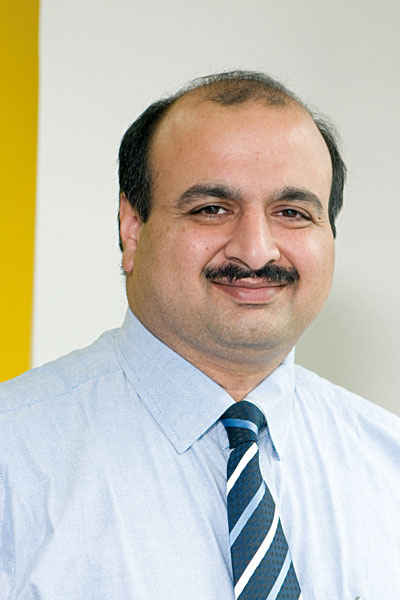Map your dreams!
By
Nash David |
Updated on 14-Oct-2011

Himanshu Goyal is the Country Manager for Academic & Developer Relations, Career Education and Localization, IBM Software India/South Asia. He shared his thoughts on varied topics – from the history of IBM to its contribution towards enhancing the academic and developer talent pool.
Himanshu Goyal, Country Manager, Academic & Developer Relations, Career Education and Localization, IBM Software India/South Asia.
What are the activities initiated by developerworks?
Through developerWorks, we constantly look at engaging developers and encouraging them to try their hands at IBM software. For instance, the IBM Developer Superstar contest challenged Indian developers to conceptualise smart application ideas, and build a prototype using IBM software.
Our pan-India road show last year, Develothon, attracted a large following. Over 40 days, our software and technical experts conducted briefings and lectures at various engineering colleges and cities for the developer audience on emerging technologies such as cloud computing, business intelligence, mashups, collaborative solutions etc.
The developerWorks platform itself (ibm.com/developerWorks) is probably the most extensive resource you would find on IBM software and open technologies, providing in-depth technical know-how coupled with the advantages of a social network in My developerWorks.
How would you rate the education system in India?
Our education system is definitely one of the best in the world. Sure, there is always room for improvement, but the emphasis on the basic building blocks in our education system serves as very good starting point for anyone starting their career.
Where our system lacks however, and I find this specific to the IT Industry, is the lack of experiential learning coupled with functional competencies. For instance, if you were to take a look at career paths for professions such as academicians or doctors, you would find each step very structured, in terms of defined education paths and experiential learning. Take the Medical Professional as an example – after doing an MBBS, the budding doctor would be required to do a house job for practical training, post which he/she could look at doing a Masters in a discipline of his/her choice and so on. By the end of the graduation, the doctor is quite clear on the specialization he/she will like to choose. In contrast if we look at Computer Science and Engineering, the unfortunate reality is that by the end of the final year, the student is only looking at getting a job but is still unclear of what is the area of specialization he wants to pursue there onwards due to the surfeit of career options there after.
Our solution to this lacuna is the IBM Career Education Program. This program checks the basic skill areas of the candidate in three basic strengths, whether he is an observer, planner or a doer. We further broaden this, to relate these key strength areas to disciplines of Quality, Manager and Engineering, and provide detailed career paths for the young professionals that help them gain all the relevant skills, complete an IBM-certified project and make themselves adept with largely used IBM products, equipping them with the knowledge to serve some of the largest enterprise businesses. This program brings together the latest software content, real-world industry experience, hands-on lab courses and best practices, to a single unique education platform.
What advice would you give budding software engineers/developers on picking a career opportunity? In your opinion, what are the factors that they should consider? (You can talk about the observer, leader and worker and point to QA, Project Manager, developer)
My advice would be to build on your strengths and your inherent skills. The beauty of the IT industry is that there are a plethora of career choices available, each of which provides you the flexibility to build on your strengths and interests, yet helps you reach to the role that you desire.
For instance, a person skilled in conceiving, designing and creating applications could look at the career paths for Software Engineers (or Doers as we call them) which would lead them to the role of a Principal Engineer or a Solution Architect or an Information Architect, etc., while someone who has a keen eye for detail, or for reviewing things and adding value to make them better should look at the career paths for a Quality Analyst (or Observer), while someone who excels at coordinating and managing people and projects and juggling multiple stakeholders, could look at the career paths for a Planner and hence build their career in the Management function.
Within each such broad career or skill options we see multiple career paths that could cater to different platforms and technologies, for instance developing embedded applications for mobile phones, ATMs, etc., enterprise applications using Java/ J2EE, etc. The key is to make an informed choice which builds on your strengths, your inherent skills, your interests, and then embark on your career path.
IBM has completed over 100 years. Could you sum it up for us?
Over the last 100 years IBM has constantly redefined innovation – think about the barcode, fractal geometry, or the first computer to beat the reigning champion at chess, the list is endless. Innovation, that has allowed Information Technology to solve real world problems. Along the way IBM has also broken many social barriers, be it our the first woman vice president in the 1943, or hiring Michael Supa , a blind psychologist in 1942 who in turn helped IBM hire 181 people with disabilities by 1943 One thing I can be sure of – the next century will be even more exciting than the one that went by.
Tell us more about IBM’s contribution to the field of Computer Science and academics as a whole.
From the primitive punched-card machines to its present-day pervasiveness, IBM has continually redefined the role of computer science in our lives. IBM and Columbia University was instrumental in the emergence of Computer Science as a new scientific discipline, with Columbia offering one of the first academic-credit courses in computing in 1946, thus catalyzing the teaching of computer science.
One of our key initiatives for engineering schools is The Great Mind Challenge Competition (TGMC), where students are engaged to participate in a national level competition, by working on industry standard projects for free. In TGMC 2010, we had over 1.5 Lac students participating in this competition, which got us an entry in the Limca Book of records.
Under another program, Project Praviin, (Praveenyam means skills in Sanskrit), we work with the top 400 engineering colleges to help them deliver structured training and certification courses to their students. In the process, we have created more than 150 Centres of Excellence (CoE) which are labs where IBM software is available for students to acquire knowledge and industry friendly training.
With select engineering colleges we are also working on setting up Innovation Labs, which would help bring together an industry-academia connect.
Is Computer Science stagnating owing to a lack of innovation in your opinion?
Hardly. As the world develops, so increases the complexity, and thus the need for innovative solutions built using computer science or technology. This in fact is basis of our Smarter Planet campaign, be it bringing heightened efficiency to public transport in Singapore, reducing crime at Memphis Police Department, United States or uncovering money laundering transactions at Grupo Bancolombia, Colombia, the role of technology is key. Konkan Railways for instance turned to computer science to help minimize the impact on the environment – electricity wastage across the Konkan route is minimized, thanks to information-flow systems & analytics that manage timely air-circulation and platform lights in the tunnels (many of them greater than 2 kilometers long) and platforms along the route. across the Konkan route only when a train is approaching the tunnel. These, and other such smart applications of computer science are what are going to make our world a better place to live in. Its applications are in fact getting even more pervasive – be it in better decision making for business, or in serving the under-privileged.

